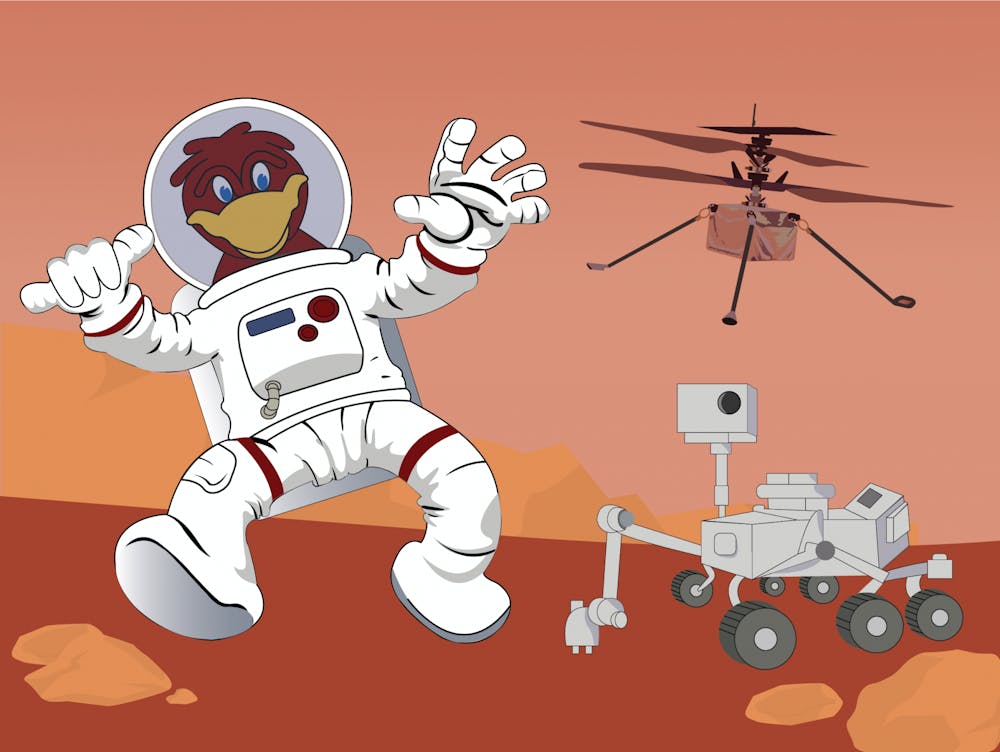When chemistry professor Mike Angel published his research on remote laser analysis in 1992, he had no idea NASA would pick it up and use it on the Curiosity mission and, most recently, the Perseverance mission.
On Feb. 18, Angel’s research landed on Mars inside the Perseverance rover to search for signs of past microbial life on the red planet. Angel specifically works on the SuperCam, which uses a remote laser and telescope to perform chemical analysis on rocks to look for trace biological signatures from up to 10 meters away.
According to Angel, he and other scientists on the Perseverance mission analyze new data from the rover as it comes from satellites orbiting Mars, summarize it and share it with the rest of the SuperCam team. This data is used to identify deposits that potentially might preserve chemical traces left behind by previous lifeforms.
"At that time, the problem I was trying to solve actually had to do with measuring the radioactive contaminants in nuclear reactors that belonged to the Department of Energy. Had nothing at all whatsoever to do with Mars or anything space," Angel said.
Remote Laser analysis is used in SuperCam by sending laser light to the remote sample, a rock for example, and collecting the light emitted or scattered by the sample by a small telescope, which is connected by an optical fiber to different instruments that analyze the signal and produce information.
"And we don't take turns; we do shifts doing this," Angel said. "We have to be trained to be able to do this because there are lots of apps and things we have to learn how to use."
Angel and his two current students are working on spatial heterodyne spectroscopy, a spectrometer that is much more advanced than the ones on SuperCam, for use on future missions to comets, asteroids and the outer planets and their moons. Third-year Ph.D. student Arelis Colon is one of the students working on this technology in Angel's lab.
"We're trying to make this [spectrometer] as small as possible. Right now, it's about an inch in size, in area ... Dr. Angel wants to make it as small as a fingernail. It's theoretically possible. It's definitely hard," Colon said. "We want to make this thing really tiny."
When in the lab, the students work on many research projects at once, but before they can begin a research project, the students need to learn how to maintain the lab.
"The first thing that I was told to do was to clean the lab, and it was purposely to figure out where everything was. So, I learned where our optics are; how to clean our optics, which is very important," Colon said.
Once Colon learned how to maintain and work safely in the lab, she moved on to applying her classroom knowledge of basic spectroscopy, which is the study of examining the structure of a material by how they respond to excitation by light.
To do this, Colon trained in Raman micro-spectroscopy, a subset of spectroscopy that combines the use of a Raman spectrometer with a microscope, to measure the properties of microscopic materials.
"You can study the theory, you can know why certain things — certain shifts happen in certain places, or how inelastic scattering works, but it's really learning how to measure a sample and knowing, 'Oh, this is a good Raman sample,' or, 'Is this a real peak or not?'" Colon said.
The students usually work eight to 10 hours a day. When it comes close to crunch time, they sometimes spend even more time in the lab. After all this hard work, they mostly get the weekends off entirely.
"I love this lab. I am so proud to be involved in what this lab is doing, and I don't think I would've found a more perfect fit for me. It is exactly what, I don't know, I think I've always wanted," Colon said. "I'm just incredibly grateful that I'm able to do something I really like."
Although some of Angel's students graduate before seeing the research used on space missions, they leave Angel’s lab interested and passionate about what they plan on doing. One such student is Alicia Strange-Fessler, a 2016 USC graduate who worked on the component for SuperCam during her time in Angel's lab.
“Dr. Angel is absolutely a reason why I'm a successful independent researcher. His passions for his research have, you know, some of them have become my passions in research, and I really enjoyed having him as my adviser," Strange-Fessler said. "I now know more about space than I ever did."

